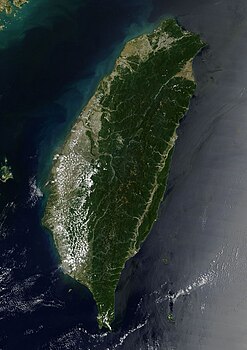
Back جغرافيا تايوان Arabic Xeografía de Taiwán AST তাইওয়ানের ভূগোল Bengali/Bangla Geografio de Tajvano Esperanto Geografía de Taiwán Spanish جغرافیای تایوان Persian Taiwanin maantiede Finnish Géographie de Taïwan French Tajvan földrajza Hungarian Geografi Taiwan ID
 Taiwan is mostly mountainous in the east, with gently sloping plains in the west. The Penghu Islands appear in the Taiwan Strait to the west of the main island. | |
 | |
| Region | East Asia |
|---|---|
| Area | Ranked 138 |
| • Total | 36,197 km2 (13,976 sq mi) |
| • Land | 89.7% |
| • Water | 10.3% |
| Coastline | 1,566.3 km (973.3 mi) |
| Highest point | Yu Shan, 3,952 m (12,966 ft) |
| Climate | Tropical marine[1] |
| Natural resources | Small deposits of coal, natural gas, limestone, marble, asbestos, arable land[1] |
| Environmental issues | Air pollution, water pollution from industrial emissions and raw sewage, contamination of drinking water, trade in endangered species, low-level radioactive waste disposal[1] |
| Exclusive economic zone | 83,231 km2 (32,136 sq mi) |
| Taiwan | |||||||||||||||||||||||||||||||||||||||||||
|---|---|---|---|---|---|---|---|---|---|---|---|---|---|---|---|---|---|---|---|---|---|---|---|---|---|---|---|---|---|---|---|---|---|---|---|---|---|---|---|---|---|---|---|
 | |||||||||||||||||||||||||||||||||||||||||||
| Traditional Chinese | 臺灣 or 台灣 | ||||||||||||||||||||||||||||||||||||||||||
| Simplified Chinese | 台湾 | ||||||||||||||||||||||||||||||||||||||||||
| Postal | Taiwan | ||||||||||||||||||||||||||||||||||||||||||
| |||||||||||||||||||||||||||||||||||||||||||
Taiwan, officially the Republic of China (ROC), is an island country in East Asia. The island of Taiwan, formerly known as Formosa, makes up 99% of the land area of the territories under ROC control. The main island is 35,808 square kilometres (13,826 sq mi) and lies some 180 kilometres (112 mi) across the Taiwan Strait from the southeastern coast of the People's Republic of China (PRC). The East China Sea lies to the north of the island, the Philippine Sea to its east, the Luzon Strait directly to its south and the South China Sea to its southwest. The ROC also controls a number of smaller islands, including the Penghu archipelago in the Taiwan Strait, the Kinmen and Matsu Islands in Fuchien near the PRC's coast, and some of the South China Sea Islands.
Geologically, the main island comprises a tilted fault block, characterized by the contrast between the eastern two-thirds, consisting mostly of five rugged mountain ranges running parallel to the east coast, and the flat to gently rolling plains of the western third, where the majority of the population resides. Several peaks exceed 3,500 m in height - the highest, Yu Shan at 3,952 m (12,966 ft), makes Taiwan the world's fourth-highest island. The tectonic boundary that formed these ranges remains active, and the island experiences many earthquakes, some of them highly destructive. There are also many[quantify] active submarine volcanoes in the Taiwan Straits.
The climate ranges from tropical in the south to subtropical in the north, and is governed by the East Asian Monsoon. On average, four typhoons strike the main island each year. The heavily forested eastern mountains provide a habitat for a diverse range of wildlife, while human land use in the western and northern lowlands is intensive.
© MMXXIII Rich X Search. We shall prevail. All rights reserved. Rich X Search